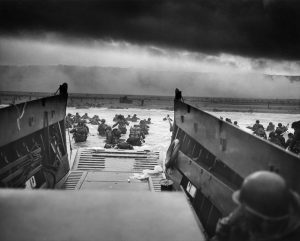The 80th anniversary of the D-Day invasion at Normandy has turned into a rather solemn occasion since European security today remains deeply troubled. Yet, thinking hard about the stunning Allied victory on the beaches of France 80 years ago could actually turn out to be quite significant for adjusting to the new realities of the Indo-Pacific region.
Military experts have long pointed out that if China tried to invade Taiwan they would need to attack on a scale comparable to the Allied invasion of Normandy. The width of the Taiwan Strait is quite comparable to the width of the English Channel in the vicinity of Normandy – just under 100 miles. Moreover, the Chinese military, the People’s Liberation Army (PLA), has been intensively studying all aspects of the Normandy campaign for decades.
Earlier this year, a Chinese-language analysis in Guofang Bao, one of the PLA’s leading newspapers, detailed how Allied airpower played the key role in the D-Say invasion by preventing “the German army’s powerful strategic and operational reserves …[from] concentrating to organize large-scale anti-landing operations.”
In a recently published scholarly article, I conclude that the PLA has been methodically poring over lessons from D-Day, and that these lessons also seem to have directly impacted their preparations for a Taiwan contingency. On the naval side, in particular, they have taken a distinct interest in the role of sea mines in the D-Day operations, noting that hundreds of mine clearance vessels were used by the Allies to clear the way for the invasion armada.
Chinese military planners also realize that the Allies deployed almost 7,000 sea mines of their own during the invasion in order to block the eastern entrance to the English Channel – thus decreasing the chances that the German Navy could attack the invasion force. The imperative to similarly block the Taiwan Strait could actually form one of the most decisive aspects of a Chinese naval effort to support an invasion of Taiwan. Other naval insights that the PLA has taken from this campaign include the necessity to develop artificial ports and the large portion of the invasion armada that was comprised of civilian ships.
Another set of Chinese lessons are related to Allied air superiority over the landing beaches. Indeed, PLA appraisals put “extreme disparity” at approximately 20:1 in fighter aircraft. As noted above, Allied control of the air allowed U.S. and British bombers to pulverize German supply lines. Most critically, Allied bombers also succeeded in taking out the Nazi coastal radar systems, effectively blinding the adversary. Chinese military analysts believe these attacks were essential to the crucial airborne (parachute and glider) operations that created havoc in the German rear.
Chinese sources repeatedly stress the importance of these airborne operations for enabling the beach landings. They even quote General Dwight Eisenhower, who when confronted by the estimates of his staff that Allied airborne forces could suffer as high as 50 percent casualties, responded that it was necessary to take such risks. Notably, the Chinese airborne forces have been built up over the last decade, so they might be able to deliver tens of thousands of troops onto Taiwan in the first 24 hours of an invasion.
A final crucial theme of Chinese assessments of D-Day is the understanding that surprise and deception are critical to success in amphibious warfare. Thus, one Chinese analysis discusses in detail the Allied ruse that caused the Germans to “defend strongly at Calais, but only lightly at Normandy.” According to one Chinese rendering, this allowed the Allied invaders to take advantage of a “weak point in the adversary’s defense, avoiding strength and striking into the gaps.”
Many Western defense analysts consider D-Day and mistakenly conclude China could never pull off an operation of this complexity. It’s true that the PLA will not have had the benefit of practice runs that the Allies had, whether at Sicily or Tarawa. Yet, PLA commanders will also have many advantages that Eisenhower did not have, such as access to satellite reconnaissance, drones, and attack helicopters. Moreover, the PLA will be confronting neither the “Atlantic Wall” nor the Wehrmacht, one of the most experienced and effective armies in history.
Finally, it’s good to remember that, for all the heroics of D-Day, total losses to the invasion force were a rather minimal 4,400 killed out of 150,000 invaders coming ashore. Surely, the PLA can expect to lose a much higher percentage of its attackers, and Beijing will accept such losses. Strategists with a true appreciation of what occurred on D-Day should realize that, in fact, China could execute an all-out invasion.
To avoid the nightmare scenario of a Taiwan contingency, U.S. leaders should strive much more proactively for a diplomatic solution, rather than seeking for desperate military measures aiming to redress the military balance across the Taiwan Strait that disappeared long ago.

































